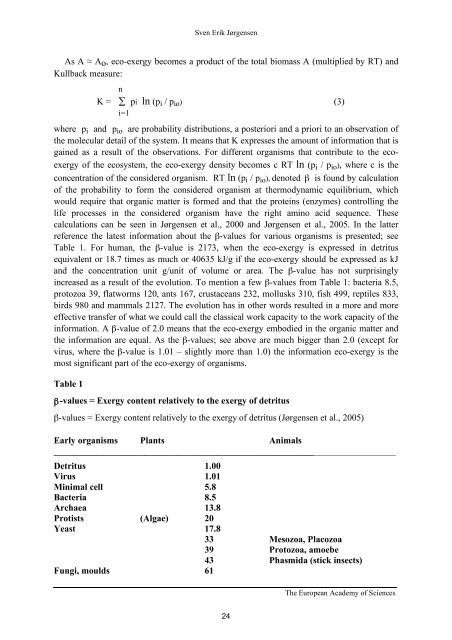An Integrated Ecosystem Theory - European Academy of Sciences
An Integrated Ecosystem Theory - European Academy of Sciences
An Integrated Ecosystem Theory - European Academy of Sciences
Create successful ePaper yourself
Turn your PDF publications into a flip-book with our unique Google optimized e-Paper software.
Sven Erik Jørgensen<br />
As A ≈ Ao, eco-exergy becomes a product <strong>of</strong> the total biomass A (multiplied by RT) and<br />
Kullback measure:<br />
n<br />
K = ∑ pi ln (p i / p io ) (3)<br />
i=1<br />
where p i and p io are probability distributions, a posteriori and a priori to an observation <strong>of</strong><br />
the molecular detail <strong>of</strong> the system. It means that K expresses the amount <strong>of</strong> information that is<br />
gained as a result <strong>of</strong> the observations. For different organisms that contribute to the ecoexergy<br />
<strong>of</strong> the ecosystem, the eco-exergy density becomes c RT ln (p i / p io ), where c is the<br />
concentration <strong>of</strong> the considered organism. RT ln (p i / p io ), denoted β is found by calculation<br />
<strong>of</strong> the probability to form the considered organism at thermodynamic equilibrium, which<br />
would require that organic matter is formed and that the proteins (enzymes) controlling the<br />
life processes in the considered organism have the right amino acid sequence. These<br />
calculations can be seen in Jørgensen et al., 2000 and Jørgensen et al., 2005. In the latter<br />
reference the latest information about the β-values for various organisms is presented; see<br />
Table 1. For human, the β-value is 2173, when the eco-exergy is expressed in detritus<br />
equivalent or 18.7 times as much or 40635 kJ/g if the eco-exergy should be expressed as kJ<br />
and the concentration unit g/unit <strong>of</strong> volume or area. The β-value has not surprisingly<br />
increased as a result <strong>of</strong> the evolution. To mention a few β-values from Table 1: bacteria 8.5,<br />
protozoa 39, flatworms 120, ants 167, crustaceans 232, mollusks 310, fish 499, reptiles 833,<br />
birds 980 and mammals 2127. The evolution has in other words resulted in a more and more<br />
effective transfer <strong>of</strong> what we could call the classical work capacity to the work capacity <strong>of</strong> the<br />
information. A β-value <strong>of</strong> 2.0 means that the eco-exergy embodied in the organic matter and<br />
the information are equal. As the β-values; see above are much bigger than 2.0 (except for<br />
virus, where the β-value is 1.01 – slightly more than 1.0) the information eco-exergy is the<br />
most significant part <strong>of</strong> the eco-exergy <strong>of</strong> organisms.<br />
Table 1<br />
β-values = Exergy content relatively to the exergy <strong>of</strong> detritus<br />
β-values = Exergy content relatively to the exergy <strong>of</strong> detritus (Jørgensen et al., 2005)<br />
Early organisms Plants <strong>An</strong>imals<br />
___________________________________________________________________________<br />
Detritus 1.00<br />
Virus 1.01<br />
Minimal cell 5.8<br />
Bacteria 8.5<br />
Archaea 13.8<br />
Protists (Algae) 20<br />
Yeast 17.8<br />
33 Mesozoa, Placozoa<br />
39 Protozoa, amoebe<br />
43 Phasmida (stick insects)<br />
Fungi, moulds 61<br />
The <strong>European</strong> <strong>Academy</strong> <strong>of</strong> <strong>Sciences</strong><br />
24


